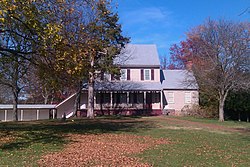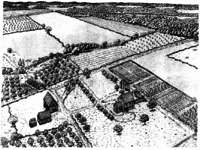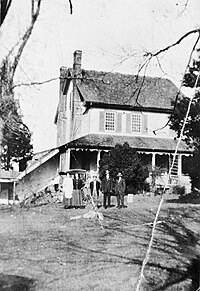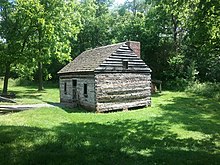
Chantilly is a census-designated place (CDP) in western Fairfax County, Virginia. The population was 24,301 as of the 2020 census. Chantilly is named after an early-19th-century mansion and farm, which in turn took the name of an 18th-century plantation that was located in Westmoreland County, Virginia. The name "Chantilly" originated in France with the Château de Chantilly, about 28 miles north of Paris.

The Northern Neck is the northernmost of three peninsulas on the western shore of the Chesapeake Bay in the Commonwealth of Virginia. The Potomac River forms the northern boundary of the peninsula; the Rappahannock River demarcates it on the south. The Northern Neck encompasses the following Virginia counties: Lancaster, Northumberland, Richmond, King George and Westmoreland; it had a total population of 50,158 as of the 2020 census.

Henry Lee III was an early American Patriot and U.S. politician who served as the ninth Governor of Virginia and as the Virginia Representative to the United States Congress. Lee's service during the American Revolution as a cavalry officer in the Continental Army earned him the nickname by which he is best known, "Light-Horse Harry". He was the father of Robert E. Lee, who led the Army of Northern Virginia against the Union Army during the American Civil War.

Samuel Phillips Lee was an officer of the United States Navy. In the American Civil War, he took part in the New Orleans campaign before commanding the North Atlantic Blockading Squadron, covering the coastlines and inland waters of Virginia and North Carolina, and finally the Mississippi River Squadron. As a cousin of Robert E. Lee, his refusal to join the Confederates' side by remaining loyal to the U.S. demonstrated how the war had divided families. Lee married Elizabeth Blair the daughter of Francis P. Blair Sr., and their house in Washington is now the president's official guest house.
The Fairfax County Park Authority is the department of the Fairfax County, Virginiagovernment responsible for developing and maintaining the various parks, historical sites, and recreational areas owned or administered by Fairfax County. Figures published as of 2003 indicate that the Park Authority manages over 22,617 acres (92 km2) of parkland.

Stratford Hall is a historic house museum near Lerty in Westmoreland County, Virginia. It was the plantation house of four generations of the Lee family of Virginia. Stratford Hall is the boyhood home of two Founding Fathers of the United States and signers of the Declaration of Independence, Richard Henry Lee (1732–1794), and Francis Lightfoot Lee (1734–1797). Stratford Hall is also the birthplace of Robert E. Lee (1807–1870), who served as General-in-Chief of the Confederate States Army during the American Civil War (1861–1865). The Stratford Hall estate was designated a National Historic Landmark in 1960, under the care of the National Park Service in the U.S. Department of the Interior.

The Lee family of the United States is a historically significant Virginia and Maryland political family, whose many prominent members are known for their accomplishments in politics and the military. The family became prominent in colonial British America when Richard Lee I immigrated to Colonial Virginia in 1639 and made his fortune in tobacco.

Richard Bland Lee was an American planter, jurist, and politician from Fairfax County, Virginia. He was the son of Henry Lee II (1730–1787) of "Leesylvania" and Lucy Grymes (1734–1792), as well as a younger brother of both Maj. Gen. Henry Lee (1756–1818) and of Charles Lee (1758–1815), Attorney General of the United States from 1795 to 1801, who served in both the Washington and Adams administrations.
Thomas Ludwell Lee, Sr. was a Virginia planter and politician who served in the House of Burgesses and later the Virginia Senate, and may be best known as one of the editors of the Virginia Declaration of Rights.

Leesylvania State Park is located in the southeastern part of Prince William County, Virginia. The land was donated in 1978 by philanthropist Daniel K. Ludwig, and the park was dedicated in 1985 and opened full-time in 1992.

Col. Henry Lee II (1730–1787) of Alexandria, Westmoreland, Virginia Colony, was an American planter, soldier, and politician, the father of Henry "Light-Horse Harry" Lee III, and grandfather of Robert E. Lee.

Strawberry Vale Manor was built in about 1780 on land that later became part of Tysons Corner, Virginia, United States. It was located about 200 yards from Virginia State Highway 123 just west of the Capital Beltway. Prior to 1811, the residence was owned by John C. Scott, and transferred by him to the ownership of Theodorick Lee, younger brother of former Congressman Richard Bland Lee in that year. After selling their estate "Sully" in 1811 to Francis Lightfoot Lee, Richard Bland and Elizabeth Collins Lee lived for a brief time in Alexandria, Virginia before purchasing Strawberry Vale from Theodorick Lee in 1812, netting Theodorick an $8,000 profit. They lived at Strawberry Vale until 1814 when the property was transferred to the Gantt family. Ann Beale Wilson Gantt ran Strawberry Vale as a seminary until it was closed at the onset of the American Civil War.

Menokin, also known as Francis Lightfoot Lee House, was the plantation of Francis Lightfoot Lee near Warsaw, Virginia, built for him by his wife's father, John Tayloe II, of nearby Mount Airy. Lee, a Founding Father, was a signer of the United States Declaration of Independence. Menokin was declared a National Historic Landmark in 1971.

The Historic Fairfax County Courthouse is one of the oldest buildings in Fairfax, Virginia. It was constructed in 1799 to serve as the seat of government in Fairfax County. During the American Civil War, the first Confederate officer casualty of the war took place on the courthouse grounds and the building was occupied by both sides in the conflict. Today, the original courthouse building is part of the larger courthouse site that serves the local government of Fairfax County.
Belvale is an historic house in present-day Fairfax County, Virginia built between 1763 and 1766 by George Johnston (1700–1766), member of the Virginia Assembly 1758–1766, friend of Patrick Henry, and legal advisor to George Washington, who was a frequent visitor to the home. The home's original lands, described as lying on "Doeg's Run", were first granted on July 6, 1698 to Richard Carpenter, who bequeathed them in 1750 to his wife Mary and daughter Ann, who sold the property to Johnston in 1763. Belvale is sometimes called "Belle Vale Manor" in historical records. Belvale was Johnston's country seat; his town home was in the city of Alexandria.
Mary Kittamaquund, daughter of the Piscataway chieftain Kittamaquund, helped establish peaceful relations between English immigrants to the Maryland and Virginia Colonies and their native peoples.

Ditchley is a historic plantation house located near Kilmarnock, Northumberland County, Virginia. It was built in 1762, and is a two-story, Georgian style brick mansion with a hipped roof. It consists of a five bay main block flanked by one-story wings. The house was renovated and modernized in the 1930s by noted philanthropist Jessie Ball duPont (1884-1970). Also on the property are two contributing smokehouses and the Lee family cemetery and site of a kitchen building.
Leesylvania was a plantation and historic home in Prince William County, Virginia, now part of Leesylvania State Park. During the 18th century, it was the home of Henry Lee II, his family and numerous slaves, and known for its productive land and especially the quality of its tobacco. Lee's sons Henry "Light-Horse Harry" Lee, Richard Bland Lee and Charles Lee, held prominent positions in Virginia during the American Revolutionary War and early federal government.
Ludwell Lee was a prominent Virginia lawyer and planter who served in both houses of the Virginia General Assembly representing Prince William and Fairfax Counties and rose to become the Speaker of the Virginia Senate. Beginning in 1799, following the death of his first wife, Lee built Belmont Manor, a planation house in Loudoun County, Virginia, which today is on the National Register of Historic Places.




































